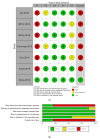Postembolization Syndrome after Prostatic Artery Embolization: A Systematic Review
- PMID: 32878325
- PMCID: PMC7555179
- DOI: 10.3390/diagnostics10090659
Postembolization Syndrome after Prostatic Artery Embolization: A Systematic Review
Abstract
Postembolization syndrome (PES) is the most common side effect of vascular embolization of solid organs. The aim of this review was to determine the incidence of PES and its individual components after prostatic artery embolization (PAE). A systematic review with a pre-specified search strategy for PubMed, Embase, Web of Science and Cochrane Library was performed according to PRISMA guidelines. Studies in English regarding PAE in humans with 10 or more participants were eligible for inclusion. No restrictions on participant demographics or PAE technique were imposed. The search returned 378 references, of which 32 studies with a total of 2116 patients met the inclusion criteria. The results for overall PES frequency and individual PES components were presented as median (interquartile range, (IQR)). Overall median PES frequency was 25.5% (12.5-45.8). The two most frequent individual PES components were dysuria/urethral burning and local pain, with a median frequency of 21.7% (13.8-33.3) and 20% (5.4-29.4), respectively. Most outcome measures were characterized by a marked lack of uniformity and inconsistency in reporting across studies. Development of a uniform reporting system would help the clinicians recognize and treat PES accordingly.
Keywords: benign prostatic hyperplasia; postembolization syndrome; prostatic artery embolization.
Conflict of interest statement
The authors declare no conflict of interest.
Figures





References
-
- Irwin D.E., Kopp Z.S., Agatep B., Milsom I., Abrams P. Worldwide prevalence estimates of lower urinary tract symptoms, overactive bladder, urinary incontinence and bladder outlet obstruction: Worldwide prevalence of luts. BJU Int. 2011;108:1132–1138. doi: 10.1111/j.1464-410X.2010.09993.x. - DOI - PubMed
-
- Gao Y., Huang Y., Zhang R., Yang Y., Zhang Q., Hou M., Wang Y. Benign Prostatic Hyperplasia: Prostatic Arterial Embolization versus Transurethral Resection of the Prostate—A Prospective, Randomized, and Controlled Clinical Trial. Radiology. 2014;270:920–928. doi: 10.1148/radiol.13122803. - DOI - PubMed
Publication types
LinkOut - more resources
Full Text Sources
Miscellaneous

